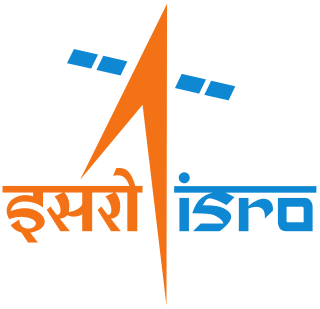
The Indian National Satellite SystemINSAT, is a series of multipurpose geostationary satellites launched by ISRO to satisfy telecommunications, broadcasting, meteorology, and search and rescue operations. Commissioned in 1983, INSAT is the largest domestic communication system in the Indo-Pacific Region. It is a joint venture of the Department of Space, Department of Telecommunications, India Meteorological Department, All India Radio and Doordarshan. The overall coordination and management of INSAT system rests with the Secretary-level INSAT Coordination Committee.

Geosynchronous Satellite Launch Vehicle (GSLV) is an expendable launch system operated by the Indian Space Research Organisation (ISRO). GSLV was used in fifteen launches from 2001 to 2023.

The Indian Space Research Organisation, commonly referred to as ISRO, is the national space agency of India. It operates under the Department of Space (DOS) which is directly overseen by the Prime Minister of India, while the Chairman of ISRO also acts as the executive of DOS. ISRO is primarily responsible for performing tasks related to space-based applications, space exploration, international space cooperation and the development of related technologies. It is one of the six government space agencies in the world which possess full launch capabilities, deploy cryogenic engines, launch extraterrestrial missions and operates a large fleet of artificial satellites.

The GSAT satellites are India's indigenously developed communications satellites, used for digital audio, data and video broadcasting. As of 5 December 2018, 20 GSAT satellites of ISRO have been launched out of which 14 satellites are in service.

The Launch Vehicle Mark-3 or LVM3 is a three-stage medium-lift launch vehicle developed by the Indian Space Research Organisation (ISRO). Primarily designed to launch communication satellites into geostationary orbit, it is also due to launch crewed missions under the Indian Human Spaceflight Programme. LVM3 has a higher payload capacity than its predecessor, GSLV.

GSAT-4, also known as HealthSat, was an experimental communication and navigation satellite launched in April 2010 by the Indian Space Research Organisation on the maiden flight of the Geosynchronous Satellite Launch Vehicle Mk.II rocket. It failed to reach orbit after the rocket's third stage malfunctioned. The third stage was the first Indian-built cryogenic-fuelled upper stage, and was making its first flight. The ISRO suspects that the failure was caused by the third stage not igniting.
GSAT-5P, or GSAT-5 Prime, was an Indian communications satellite which was lost in a launch failure in December 2010. Part of the Indian National Satellite System, it was intended to operate in geosynchronous orbit as a replacement for INSAT-3E.
GSAT-14 is an Indian communications satellite launched in January 2014. It replaced the GSAT-3 satellite, which was launched in 2004. GSAT-14 was launched by a Geosynchronous Satellite Launch Vehicle Mk.II, which incorporated an Indian-built cryogenic engine on the third stage.
GSAT-10 is an Indian communication satellite which was launched by Ariane-5ECA carrier rocket in September 2012. It has 12 KU Band, 12 C Band and 6 lower extended c band transponders, and included a navigation payload to augment GAGAN capacity. Following its launch and on-orbit testing, it was placed in Geosynchronous orbit at 83.0° East, from where it will provide communication services in India.

INSAT-4E, also known as GSAT-6, is a member of the INSAT family and is a multimedia communication satellite that will offer a Satellite Digital Multimedia Broadcasting (S-DMB) service across several digital multimedia terminals or consoles which can be used to provide information services to vehicles on the fly and to the mobile phones. The satellite can be used for other social and strategic applications.
GSAT-7 or INSAT-4F is a multi-band military communications satellite developed by the Indian Space Research Organisation. The Indian Navy is the user of the multi-band communication spacecraft, which has been operational since September 2013. According to defense experts, the satellite will enable the navy to extend its blue water capabilities and stop relying on foreign satellites like Inmarsat, which provide communication services to its ships.

GSAT-7A is an advanced military communications satellite meant primarily for the Indian Air Force with Indian Army using 30% of capacity.

The South Asia Satellite, formerly known as SAARC Satellite, is a geostationary communications and meteorology satellite operated by the Indian Space Research Organisation for the South Asian Association for Regional Cooperation (SAARC) region. The satellite was launched on 5 May 2017. During the 18th SAARC summit held in Nepal in 2014, Indian Prime Minister Narendra Modi mooted the idea of a satellite serving the needs of SAARC member nations as a part of his neighbourhood first policy. Afghanistan, Bangladesh, Bhutan, Maldives, Nepal and Sri Lanka are the users of the multi-dimensional facilities provided by the satellite.

INSAT-3DR is an Indian weather satellite built by the Indian Space Research Organisation and operated by the Indian National Satellite System. It will provide meteorological services to India using a 6-channel imager and a 19-channel sounder, as well as search and rescue information and message relay for terrestrial data collection platforms. The satellite was launched on 8 September 2016, and is a follow-up to INSAT-3D.

GSAT-19 is an Indian communications satellite launched by the Indian Space Research Organisation aboard a GSLV Mark III on 5 June 2017.

GSAT-6A was a communication satellite launched by the Indian Space Research Organisation (ISRO) It featured a 6-metre (20 ft) unfurlable S-band antenna similar to the one used on GSAT-6. Around 17 minutes after lift-off, the three stage GSLV Mk.II rocket flying on GSLV F08 mission successfully injected the satellite into a geosynchronous transfer orbit. Due to power failure during its orbit raising burns the communication was lost with GSAT-6A before it could reach its final circular geostationary orbit (GSO).
GSAT-20 is a communication satellite jointly being developed by Indian Space Research Organisation Satellite Centre and Liquid Propulsion Systems Centre and will be launched by ISRO. GSAT-20 will be a continuation of GSAT series of communication satellites. The satellite is intended to add data transmission capacity to the communication infrastructure required by Smart Cities Mission of India.













